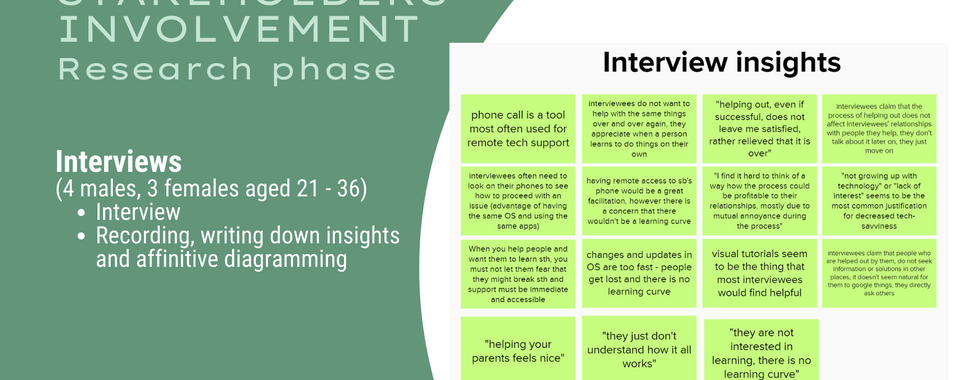Shäre App: Design For The Elderly
- Anna Korczak
- Jun 14, 2022
- 6 min read
Individual project
Tools: Mural, Figma, Canva
During Studio II course within Interaction Design program at Malmö University, I introduced a design of the Shäre app. Having in mind that the app yet needs long-term evaluation to assess whether it meets the design goals, I am trying to explore the question whether people can build and maintain intergenerational relationships through technology and support in using technology.

Background
Due to elongating life span of humans, globalization trends and progressing digitalization of life, remote communication plays more and more significant role in our lives. People not only communicate using information and communications technologies (ICT) for professional purposes, but also to maintain relationships within families. People of different generations have different levels of digital literacy, with younger being digital natives and older being digital immigrants. With elderly and people with limited digital literacy being increasingly involved into using ICT tools on a daily basis, remote tech support and scaffolding activities have become a significant part of intergenerational communication.
Detailed description of background research results can be found in the accompanying paper:
Problems
1. Exclusion of seniors and non-tech-savvy people
Seniors, who were not brought up with technology, as well as younger people with digital literacy limited of various reasons, might often feel excluded in our digital society, where almost everyone seems to be attached to their mobile devices as crucial tools in everyday life. Being not up to date with technology not only constrains elderly and less tech-savvy people in handling simple tasks and daily errands online, but also limits their options to communicate with friends and family and the pool of common topics they can bring up with their close ones.
2. Lack of tools to help them adjust and address their problems
Above mentioned people have trouble with recognizing and addressing their problems when they use technology, so they must rely on family and friends to help them out. However, they do not want to be seen as a burden to their family members, who have their own problems to solve. Being often away from people who might help, and hesitating to ask for the favor, non-tech-savvy people often give up due to lack of accessible tools designed for effortless remote tech support.
3. Lack of learning curve
On the other hand, elderly often seem to be comfortable with their digital immigrancy; they do not learn and often do not want to learn. They ask about the same things all over again or even refuse help at some point.
4. Neutral or negative effect on relationships
Such situations may cause mutual annoyance and frustrations. Overall, the process of tech support is negative or neutral for relationships between helpers and helpees and for the well-being of both parts.
Design opportunities
By creating this design, I am exploring a range of design opportunities concerning intergenerational remote trouble shooting and tech support and their effects on relationships within multigenerational families. I am investigating how might we make the process effortless for both sides, how to ensure a learning curve for less tech-savvy people and perchance increase their interest in technology and whether it is possible for the remote tech support process to be profitable for intergenerational relationships. Most of all, I am trying to address the question whether people can build and maintain relationship through technology and support in using technology.
The design process
Final concept overview
Shäre is a mobile app which is aimed to strengthen family communication and bonds through enabling intergenerational remote tech support and scaffolding activities. The targeted group of users are seniors and people with limited digital literacy and their family members.
Accessibility
The design takes accessibility principles into account: the colours are calm and have proper contrasts; font size and style is appropriate for most of users with age-related vision impairments; buttons and clickable areas have appropriate size and spaces between elements take limited motor skills of elderly into account; icons and descriptions back up each other; there are no hidden functions; the app provides informative pop-ups, prompts and function descriptions; communication language is adjusted for people of every age and non-tech-savvy users and lacks complicated tech-related vocabulary.
Communication and tech support/scaffolding activities
The app holds most of the functions typical for popular communication apps: calls/video calls, chats, photo/video sharing, access to gallery of saved media, contact list and settings. Moreover, it provides solutions for instant, remote and effective tech support – users are able to share their screens or remotely access and control the other device.
Enabling a learning curve
The sessions are recorded on default and after the end of each session, users are asked whether they wish to save the video in a form of a tutorial for a future reference. They can edit the video on the spot by cutting it to the proper length, adding markings and text. The video is saved to a pre-set category under a descriptive title. To ensure a learning curve, tutorials may be easily found later on, as they are sorted by time and category and can be searched by key words in titles. The saved tutorials are also editable. When played, they overflow the app that user is working in, so they are accessible and visible while executing the activities provided in the instruction. The window with the overflowing video may be enlarge to the full size by double tapping and minimized in the same manner. It can be instantly paused and played and exited due to respective buttons.
Moreover, featured news and fun facts from ICT industry aim to increase users’ interest in technology and Internet and smartphone use.
Strengthening relationships
Shäre enables sharing of photos and videos in a chat and directly from the gallery of saved media. In the gallery a pop-up with Memories to share prompts users to share media from respective day in the past in order to recall and memorize shared experiences.
Family events and issued may also be recollected and shared by setting the safety questions and answers to them. In order to allow access to one’s phone, a user needs to pick a pre-set safety question which is asked to the other user. Such questions not only allow to bring back memories of internal family affairs but are also a way to identify a user that is meant to access and control one’s phone, as a person with a unique knowledge.
After every call, a user can send a pleasant card to their interlocutor, in order to express positive feelings such as gratefulness for helping out, love or best wishes for the day.
As family members sometimes lack common areas of interest and therefore subjects to talk about, the above-mentioned featured facts and news in chat are also meant to provide topics for conversations.
Finally, to avoid mutual irritation, picking the right time to contact a family member and ask for their help, seems to be crucial. Therefore, the app provides indications of online/offline status of every user in a form of a colourful circle around the avatar.
Privacy and security
Privacy settings and customer support options are placed in settings. They are inspired by solutions provided in WhatsApp and TeamViewer. The adjustable issues are: two-factor authentication for logging in; visibility (online/offline status), safety questions and answers; trusted devices; restricted devices; settings of session recording and media. The app should provide insight to its privacy policy and licences as well as access to help center and direct contact.
These issues are an area for future work and should be brought up in the later stages of product implementation.

Conclusion
According to opinions of potential users, Shäre app mostly serves its goal. It provides solutions for instant and remote tech support and at the same time it is adapted for less tech-savvy users and use within families. It has potential to strengthen family bonds by providing shareable positive experiences in a family setting. By using Shäre, family members of different generations have a chance to turn something as troublesome as remote tech support to a positive experience aimed at being profitable for their relationships. After consulting the project with various people, I see a great opportunity in developing and releasing such a solution to the market of mobile applications.
The goal of this design plays its role in today’s digital society and contributes to the field of interaction design by addressing the issues of maintaining relationships through technology. It does not explore how profitable is remote and digital communication comparing to the one in person, but rather investigates whether technology and digitalization may be a reason to keep in touch with each other and build relationships upon. Through my design, I am trying to address the issues of digital socialization and the role of modern family in this process as it seems that that ICT tools become more and more significant elements of our lives as individuals and members of society.









































Comments